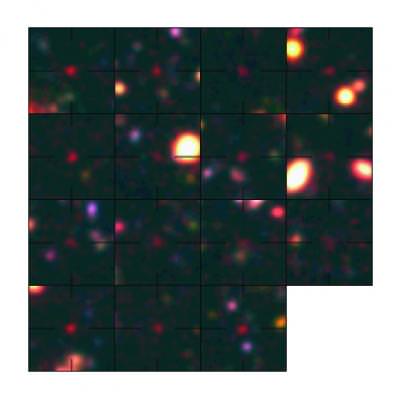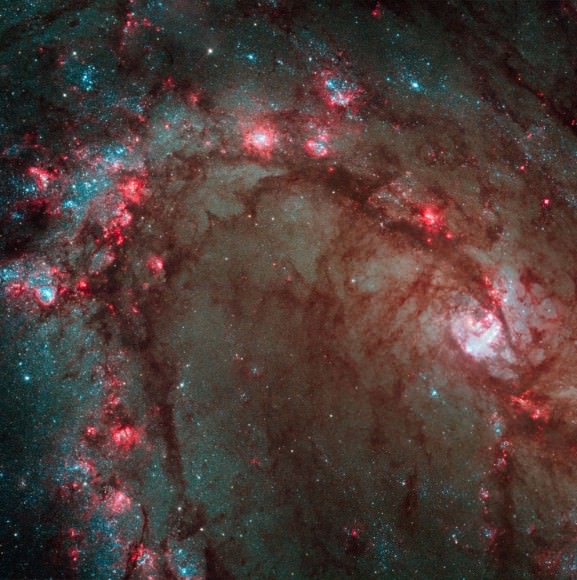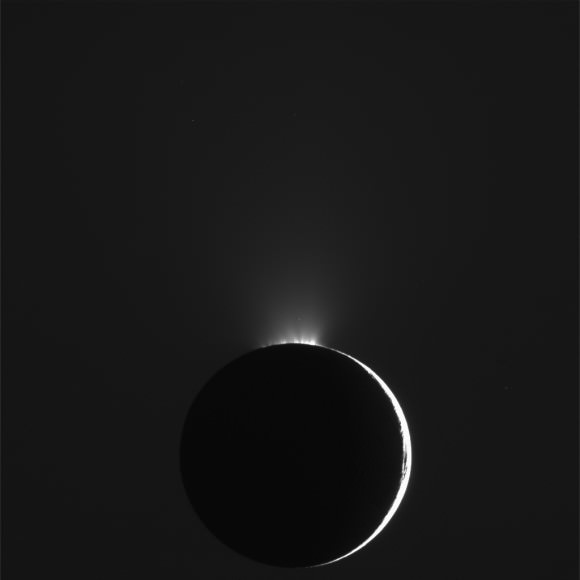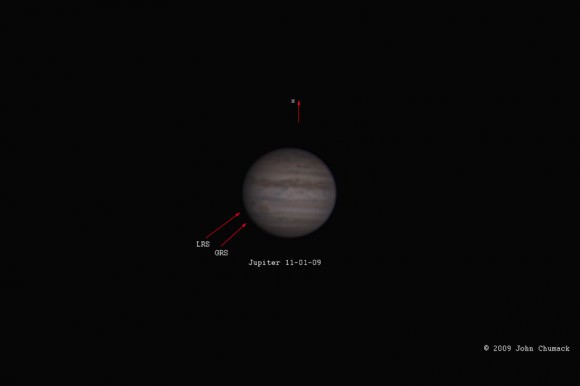Space Junk May Force Crew from ISS

Update #2, 5:30 pm: NASA has now said that after further analysis, the space debris they have been tracking no longer poses any concern or threat to the ISS. Everyone can rest easy tonight! The piece of debris was only 5 cm long, and will not pass within the "pizza box" zone around the station (0.75 x 25 x 25 kilometers) that calls for an alert.
A hard-to-track piece of space junk may come within a half a kilometer of the International Space Station later today, and NASA managers are considering asking the crew to board the docked Soyuz capsules as a precaution. The time of closest approach is at 10:48 p.m. EST, and the object was detected too late for the station to do an evasive maneuver. Depending on the outcome of additional tracking data analysis, the crew may be awakened later and directed to go into the Soyuz vehicles around 10:30 pm or given the option to sleep in Soyuz tonight. NASA says they don't believe the crew is at risk, but precautions are prudent in dealing with space debris.
(...)
Read the rest of Space Junk May Force Crew from ISS (188 words)
Early Galaxy Pinpoints Reionization Era

Astronomers looking to pinpoint when the reionozation of the Universe took place have found some of the earliest galaxies about 800 million years after the Big Bang. 22 early galaxies were found using a method that looks for far-away redshifting sources that disappear or "drop-out" at a specific wavelength. The age of one galaxy was confirmed by a characteristic neutral hydrogen signature at 787 million years after the Big Bang. The finding is the first age-confirmation of a so-called dropout galaxy at that distant time and pinpoints when the reionization epoch likely began.
(...)
Read the rest of Early Galaxy Pinpoints Reionization Era (532 words)
NASA Science News for November 6, 2009
Long ago, something calamitous happened to Mars, transforming a warm and hospitable world into the frigid, seemingly lifeless desert we see today. Many scientists believe the Red Planet lost most of its atmosphere, but how? A new NASA mission named MAVEN is specifically designed to answer that question.
FULL STORY at
http://science.nasa.gov/headlines/y2009/06nov_maven.htm?list1035898
Hubble Unveils Stunning Star Birth in M83

It appears Hubble's new Wide Field Camera 3 (WFC3) is working. And how! The new camera installed during Servicing Mission 4 in May has delivered the most detailed view of star birth in the graceful, curving arms of the nearby spiral galaxy M83. Nicknamed the Southern Pinwheel, M83 is undergoing more rapid star formation than our own Milky Way galaxy, especially in its nucleus. The sharp "eye" of WFC3 has captured hundreds of young star clusters, ancient swarms of globular star clusters, and hundreds of thousands of individual stars, mostly blue supergiants and red supergiants.
(...)
Read the rest of Hubble Unveils Stunning Star Birth in M83 (131 words)
Found: Theoretical Supernova Actually Exists
Astronomers have identified a type of supernova that appears to be a type predicted in theory but never actually observed before. Two years ago Lars Bildsten from UC Santa Barbara and his colleagues predicted a new type of supernova in distant galaxies which they dubbed the “.Ia” (point one a) mechanism, involving a helium detonation on a white dwarf, ejecting a small envelope of material. This theoretical explosion would be fainter than most other supernovae and its brightness would rise and fall in only a few weeks. Dovi Poznanski from Berkeley went back and looked at seven-year-old observations and found this unusual kind of supernova. Poznanski and colleagues say supernova 2002bj belongs in its own category, as its spectra suggest that it evolved extremely fast and produced an unusual combination of elements.
(...)
Read the rest of Found: Theoretical Supernova Actually Exists (474 words)
Multi-Planet System is Chaotic, Dusty

NASA's Spitzer Space Telescope captured this infrared image of a giant halo of very fine dust around the young star HR 8799. Image credit: NASA/JPL-Caltech/Univ. of Ariz.
Just what is going on over at the star HR 8799? The place is a mess! But we can just blame it on the kids. Young, hyperactive planets circling the star are thought to be disturbing smaller comet-like bodies, causing them to collide and kick up a huge halo of dust. HR 8799 was in the news in November 2008, for being one of the first with imaged planets. Now, NASA's Spitzer Space Telescope has taken a closer look at this planetary system and found it to be a very active, chaotic and dusty system. Ah, youth: our solar system was likely in a similar mess before our planets found their way to the stable orbits they circle in today.
Neutron Star at Core of Cas A Has Carbon Atmosphere

A Chandra X-ray Observatory image of the supernova remnant Cassiopeia A. Credit: NASA/CXC
Supernova remnant Cassiopeia A (Cas A) has always been an enigma. While the explosion that created this supernova was obviously a powerful event, the visual brightness of the outburst that occurred over 300 years ago was much less than a normal supernova, — and in fact, was overlooked in the 1600's — and astronomers don't know why. Another mystery is whether the explosion that produced Cas A left behind a neutron star, black hole, or nothing at all. But in 1999, astronomers discovered an unknown bright object at the core of Cas A. Now, new observations with the Chandra X-Ray Observatory show this object is a neutron star. But the enigmas don't end there: this neutron star has a carbon atmosphere. This is the first time this type of atmosphere has been detected around such a small, dense object.
(...)
This Week's WITU Challenge
Here's this week's image for the WITU Challenge, to test your visual knowledge of the cosmos. You know what to do: take a look at this image and see if you can determine where in the universe this image is from; give yourself extra points if you can name the spacecraft responsible for the image. We’ll provide the image today, but won’t reveal the answer until tomorrow. This gives you a chance to mull over the image and provide your answer/guess in the comment section. Please, no links or extensive explanations of what you think this is — give everyone the chance to guess.
(...)
Read the rest of This Week's WITU Challenge (0 words)
NASA May Drop Ares I-Y Test Flight
Just one week after the first test flight test of the Ares I-X rocket, NASA says it may decide to cancel a follow-up launch called Ares 1-Y, which wasn't scheduled until 2014. Reportedly, program managers recommended dropping the flight because, currently, there isn't the funding to get an upper stage engine ready in time. The test flight may be replaced with a new, still undefined test flight in 2012 or 2013. “It simply does not fit where we are headed,” said Jeff Hanley, Constellation Program manager was quoted in NASA's Constellation Blog. “The test vehicle was intended to meet evolving needs but the current configuration is too different from what the program requires to certify the Ares/Orion vehicle systems.”
(...)
Read the rest of NASA May Drop Ares I-Y Test Flight (258 words)
Do "Skeleton" Filaments Give Structure to the Universe?
This 3D illustration shows the position of the galaxies and reveals the extent of this gigantic structure. The galaxies located in the newly discovered structure are shown in red. Galaxies that are either in front or behind the structure are shown in blue. Credit: ESO
Are there "skeletons" out in the Universe –structures that form the framework of how galaxies are distributed? Astronomers have tracked down a gigantic, previously unknown assembly of galaxies located almost seven billion light-years away from us, which seems to point to a prominent galaxy structure in the distant Universe, providing further insight into the cosmic web and how it formed. “Matter is not distributed uniformly in the Universe,” says Masayuki Tanaka from ESO, who led the new study. “In our cosmic vicinity, stars form in galaxies and galaxies usually form groups and clusters of galaxies. The most widely accepted cosmological theories predict that matter also clumps on a larger scale in the so-called ‘cosmic web’, in which galaxies, embedded in filaments stretching between voids, create a gigantic wispy structure.”
(...)
Read the rest of Do "Skeleton" Filaments Give Structure to the Universe? (409 words)
Hints of More Extra-Galactic Planets
We regularly report on the discovery of extrasolar planets in our galaxy, but earlier this year came news of possibly the first planet discovered outside of the Milky Way. Now comes news of the potential discovery of dozens of extragalactic planetary systems. Erin Mentuch and her colleagues at the University of Toronto in Canada have analyzed 88 remote galaxies and found a broad continuum excess in the near-infrared. They conclude the most likely explanation for the 2-5 micron excess is the light from circumstellar disks, or young solar systems, forming around massive young stars. "[This] presents us with an exciting opportunity to measure the formation rate of planetary systems at cosmic epochs before our own Solar System formed," the team writes in their paper.
(...)
Read the rest of Hints of More Extra-Galactic Planets (160 words)
NASA Science News for November 3, 2009
The MESSENGER spacecraft's third flyby of the planet Mercury has given scientists, for the first time, an almost complete view of the planet's surface and revealed some dramatic changes in Mercury's comet-like tail.
FULL STORY at
http://science.nasa.gov/headlines/y2009/03nov_hiddenterritory.htm?list1035898
Solving the Mystery of Cosmic Rays' Origins

What accelerates cosmic rays to nearly the speed of light? Astronomer have pondered that question for nearly 100 years, and now new evidence supports a theory held for two decades that cosmic rays likely are powered by exploding stars and stellar winds. "This discovery has been predicted for almost 20 years, but until now no instrument was sensitive enough to see it," said Wystan Benbow, an astrophysicist at the Smithsonian Astrophysical Observatory who coordinated this project for the Very Energetic Radiation Imaging Telescope Array System (VERITAS) collaboration.
(...)
Read the rest of Solving the Mystery of Cosmic Rays' Origins (624 words)
Jupiter's Dueling Red Spots
Even though most of us have been suffering from poor seeing conditions due to both hemisphere's seasonal climate changes, the changes we're experiencing look like nothing compared to what's happening on Jupiter. If you think we've got turbulent atmosphere and more than our fair share of clouds – then check out what John Chumack's been watching! (...)
Read the rest of Jupiter's Dueling Red Spots (625 words)
Fabulous! Enceladus Raw Flyby Images

Carolyn Porco, the lead for Cassini's imaging team, warned on Twitter that the flyby of Saturn's moon Enceladus performed by the spacecraft on Nov. 2 wasn't really an "imaging" flyby, and that we might have to wait until the Nov. 21 flyby for really good images. But just take a look the images returned so far, with stunning looks at the jets shooting from the moon! Another image takes a close look at the surface. These are raw, unprocessed images, but what images they are! This is the second image from today's flyby returned by the spacecraft. See below for more.
(...)
Read the rest of Fabulous! Enceladus Raw Flyby Images (201 words)





